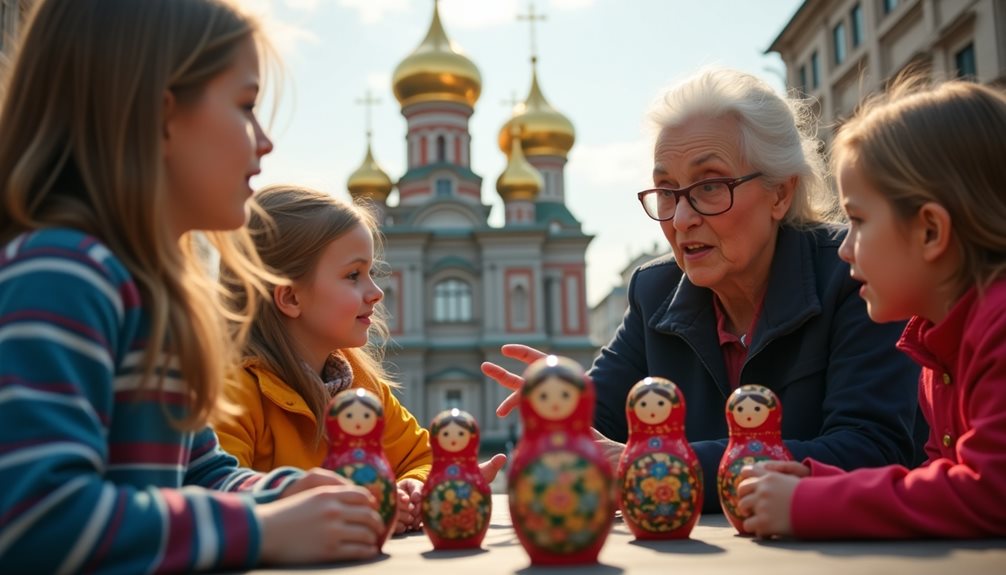The exploration of Russian culture through its linguistic features reveals intricate connections between language and societal values. The phonetic richness, marked by varied sounds and complex structures, reflects the musicality inherent in Russian expression. Grammatical frameworks signify social hierarchies, while idiomatic phrases encapsulate cultural nuances. These elements collectively contribute to a deeper understanding of identity and tradition. Yet, the question remains: how do these linguistic characteristics shape interactions in everyday life?
Table of Contents
ToggleThe Phonetic Richness of the Russian Language

The Russian language offers a striking tapestry of sounds that captivates both the casual listener and the meticulous scholar. Its phonetic richness is immediately evident in the way words are formed and pronounced, blending softness and strength, melody and rhythm. Russian boasts an extensive array of vowels, each with subtle distinctions that can change the meaning of a word entirely. For example, the difference between “мир” (mir: [meer], meaning “world” or “peace”) and “мирь” (mir’: [meer’], an archaic form) hinges on a tiny yet meaningful sound shift.
Consonant clusters—groups of consonants placed together without intervening vowels—are another hallmark of Russian phonetics. Words like “вскользь” (vskolz’: [fskolz’], meaning “in passing”) challenge even native speakers and give Russian its characteristic texture. These clusters not only test the agility of the tongue but also create a percussive quality that is both expressive and memorable.
Sound symbolism is deeply woven into Russian. Certain sounds evoke specific emotions or images, either by tradition or by the physical feeling of saying them. For instance, harsh “ш” ([sh]) or “ж” ([zh]) sounds can suggest heaviness or darkness, while light “л” ([l]) and “р” ([r]) tend to bring to mind brightness or quickness. This link between sound and sense gives Russian poetry and prose a special resonance, allowing writers and speakers to play with nuance on a sonic level.
Stress patterns in Russian are unpredictable and highly significant. The placement of stress can change not only the pronunciation but also the meaning of a word: “замок” ([ZA-muk], castle) versus “замок” ([za-MOK], lock). Intonation—the rise and fall of the voice—adds another dimension, conveying everything from questions to emotions with subtle shifts. Together, these features make Russian speech vibrant and flexible, able to express shades of meaning with ease.
Underlying these elements, Russian phonological rules dictate how sounds interact, blend, or change depending on their neighbors. These rules have evolved over centuries, reflecting the history and diversity of the Russian-speaking world. As a result, the soundscape of Russian is not only beautiful but also rich with cultural meaning, offering endless inspiration for both creative expression and academic analysis.
Grammatical Structures and Their Cultural Significance
Grammatical structures in Russian are not just rules for building sentences—they reflect deep cultural values and social expectations. The way Russians use grammar shows how they see respect, hierarchy, relationships, and even their sense of time. Learning about these aspects can help English speakers understand the Russian mindset and the society that shaped the language.
The Case System
Russian uses six grammatical cases: nominative, genitive, dative, accusative, instrumental, and prepositional. Each case answers a different question (like “who?”, “to whom?”, “with what?”) and changes the ending of the word. Unlike English, where word order is key, Russian cases show the role of each word in a sentence. This flexibility means that sentences can be rearranged for emphasis or style without losing meaning.
- Nominative (именительный падеж, imenitel’nyi padezh): marks the subject. Example: мама (mama) – “mom.”
- Genitive (родительный падеж, roditel’nyi padezh): often shows possession or absence. Example: нет молока (nyet moloka) – “no milk.”
- Dative (дательный падеж, datel’nyi padezh): indicates the indirect object. Example: дать другу (dat’ drugu) – “to give to a friend.”
- Accusative (винительный падеж, vinitel’nyi padezh): marks the direct object. Example: вижу дом (vizhu dom) – “I see a house.”
- Instrumental (творительный падеж, tvoritel’nyi padezh): used for the means or tool. Example: писать ручкой (pisat’ ruchkoy) – “to write with a pen.”
- Prepositional (предложный падеж, predlozhnyi padezh): shows location or topic. Example: в школе (v shkole) – “at school.”
This system emphasizes relationships over strict order, reflecting the Russian value of context and flexibility in communication.
Politeness and Social Hierarchies
Russian has two main forms of address: formal and informal. The choice between ты (ty) for “you” (informal, pronounced “tee”) and вы (vy) for “you” (formal/plural, pronounced “vee”) is very important. Using the wrong form can be rude or overly familiar.
- Ты is used with friends, family, children, or sometimes among young people.
- Вы is used for strangers, elders, authority figures, or in business situations.
This distinction reflects deep respect for age, status, and social distance in Russian culture. It also appears in verb endings and pronouns throughout a conversation.
Aspect in Verbs
Russian verbs often come in pairs to show either a process or a completed action—this is called aspect.
- Imperfective Aspect (несовершенный вид, nesovershennyi vid): Focuses on ongoing or repeated actions. Example: читать (chitat’, “to read”) can mean “to be reading” or “to read regularly.”
- Perfective Aspect (совершенный вид, sovershennyi vid): Shows that an action is finished. Example: прочитать (prochitat’, “to read through” or “to finish reading”).
This aspect system is central to Russian thinking about time and action. People often clarify if something was done once, is still happening, or is a repeated habit. This can reveal a cultural focus on whether results were achieved or if something is still in progress.
Key Points with Russian Examples
- The case system allows flexible word order but demands careful attention to endings.
- The formal/informal address system mirrors the importance of hierarchy and respect.
- Verb aspects reveal how Russians see time—not just what happened, but whether it’s complete.
Russian grammar is not only about structure; it’s a window into how Russians see their world and interact with each other. Words like уважение (uvazhenie – respect), семья (sem’ya – family), and дело (delo – task/affair) often appear in ways that highlight these cultural values through their grammatical forms. Understanding these features helps learners appreciate not just the language but also the culture behind it.
Idiomatic Expressions: a Window Into Russian Values
Idiomatic expressions in Russian are more than just colorful phrases—they reveal a great deal about the way Russians think, feel, and interact with the world. These expressions often draw from everyday life, history, and shared cultural experiences, making them a key to understanding Russian values and attitudes.
Russian idioms reflect core beliefs such as perseverance, skepticism, emotional strength, and limits to patience. For example, the Russian phrase “терпеть не могу” (ter-PYET’ nye ma-GOO), which means “I can’t stand it,” is commonly used to show the boundaries of one’s patience—a value that is deeply respected in Russian society. Another widely used idiom is “держать камень за пазухой” (der-ZHAT’ KA-men’ za PA-zoo-khoy), literally “to keep a stone in one’s bosom,” which refers to harboring resentment or hidden anger. This phrase highlights how emotional restraint and indirect communication can sometimes be valued over open confrontation.
Resilience is another important concept in Russian culture. The idiom “терпеть и молчать” (ter-PYET’ ee mal-CHAT’), meaning “to endure and stay silent,” shows the cultural appreciation for enduring hardship without complaint. This attitude is rooted in Russia’s long history of overcoming adversity, whether due to harsh winters, political upheaval, or economic difficulties.
Russians are also known for their caution and skepticism, especially toward strangers or unfamiliar situations. The phrase “не всё то золото, что блестит” (nye vsyo to ZO-lo-to shto blee-STEEt), which translates as “not everything that glitters is gold,” warns against trusting appearances and underscores the value placed on careful judgment.
Some commonly used Russian words and phrases related to idiomatic expressions include:
- пословица (pa-SLO-vee-tsa): proverb
- поговорка (pa-ga-VOR-ka): saying
- выражение (vi-ra-ZHE-nee-ye): expression
- образное выражение (O-bra-zna-ye vi-ra-ZHE-nee-ye): figurative expression
Through idioms like these, the Russian language acts as a mirror to the collective psyche, revealing deep-seated values such as endurance, wariness, inner strength, and a clear sense of limits. By learning and understanding these expressions, you gain not just new words but a window into how Russians view life and each other.
The Influence of Literature on Linguistic Development
Russian literature has played a major role in shaping the Russian language, influencing not only how people speak and write, but also how they think and express themselves. Over centuries, the works of famous authors—from Alexander Pushkin to Fyodor Dostoevsky and beyond—have left a lasting impact on Russian vocabulary, grammar, and style. Their influence extends far beyond books; it can be seen in everyday speech, idioms, and even the way people approach storytelling.
One of the key ways literature has influenced Russian is by reflecting and reinforcing cultural values. For example, many phrases and proverbs in Russian come directly from literary works. The saying “Тише едешь — дальше будешь” (Tishe yedesh — dalshe budesh; “The quieter you go, the further you’ll get”) captures a cautious approach to life, a theme often found in Russian stories. Literature has helped spread such ideas, making them part of daily conversation.
Literary works have also enriched the vocabulary of the Russian language. When authors explore new themes or describe emotions in unique ways, they often create or popularize words and expressions. For instance, Pushkin is credited with introducing many new words and poetic expressions into Russian. Words like “вдохновение” (vdokhnovenie; inspiration) and “тоска” (toska; a deep, aching melancholy) gained new depth through literature.
Narrative styles have evolved thanks to literature as well. In the 19th century, Russian authors experimented with different forms of storytelling—such as the use of stream-of-consciousness (поток сознания, potok soznaniya) by writers like Dostoevsky. These new styles introduced fresh sentence structures and ways of presenting dialogue, which eventually became common in both written and spoken Russian.
Some examples of literary influence on language include:
- Quoting classics: Lines from famous works are often referenced in conversation. For example, “Мой дядя самых честных правил” (Moy dyadya samykh chestnykh pravil; “My uncle was a man of the most honest principles”) from Pushkin’s “Eugene Onegin” is instantly recognizable to most Russians.
- Borrowed words: Literature sometimes borrows from other languages. For example, the word “интеллигенция” (intelligentsiya; intellectual class) became widely used after appearing in literary texts.
- Neologisms: Some authors invent entirely new words that enter common use. Gogol’s playful use of language led to expressions like “мертвые души” (mertvye dushi; “dead souls”) becoming part of everyday speech.
The result is a language that is constantly changing and growing, shaped by its artistic heritage. Russian literature does not just tell stories; it molds the very way people communicate, think, and relate to their culture. This dynamic relationship between literature and language keeps Russian vibrant and expressive, allowing speakers to capture both the ordinary and the profound with clarity and style.
Regional Dialects and Their Cultural Implications
The Russian language, while standardized in its written and formal spoken forms, is marked by a wide variety of regional dialects. These dialects are not just random differences in speech; they are deeply tied to the history, geography, and social life of each region. The development of these regional variations can be traced back to Russia’s vast size and complex history, which includes centuries of migration, trade, and cultural exchange.
For example, in Siberia (Сибирь, pronounced: see-BEER’), the local dialects often reflect influences from indigenous languages and the unique environment. Words related to nature, climate, and daily life in the taiga (тайга, pronounced: tahy-GAH; meaning: boreal forest) are common in Siberian speech. You might hear specific vocabulary for snow types or local wildlife that wouldn’t be understood by someone from Moscow.
In the Volga region (Поволжье, pronounced: pah-VOHL’-zhye), the mix of Russian with Tatar and other Turkic languages has shaped the local way of speaking. Common words and names often have a different sound or structure due to these historical influences. For example, the word чай (chai, pronounced: chahy; meaning: tea) is used all over Russia, but in the Volga region you might also hear borrowed words for food or daily activities that come from Tatar.
Some key features of Russian regional dialects:
- Pronunciation: In the North, especially around Arkhangelsk (Архангельск), people pronounce unstressed “o” more clearly than in standard Russian. This is called “оканье” (okanye, pronounced: OH-kan-ye).
- Vocabulary: Different regions use unique words for everyday things. For example, in the south, “хата” (khata, pronounced: KHAH-tah; meaning: house) is common, while in central Russia “дом” (dom, pronounced: dom) is used.
- Grammar: Certain dialects use older forms of verbs or nouns that have disappeared from standard Russian.
Regional dialects are important for more than just communication; they serve as markers of identity and pride. Local expressions, sayings, and even jokes often don’t make sense outside their home region. Folk songs, fairy tales, and proverbs are passed down in regional speech, preserving traditions that might otherwise be lost.
These dialects challenge the idea that there is only one “true” Russian culture. Instead, they show that Russia is made up of many different communities, each with its own heritage. For example:
- In the Ural Mountains (Урал, pronounced: oo-RAHL), miners developed their own slang to describe work underground.
- In the Far East (Дальний Восток, pronounced: DAHL’-nee voh-STOHK), Russian is mixed with words from Chinese or Korean due to historical contact.
Understanding these dialects gives a fuller picture of what it means to be Russian. It highlights how language is shaped by place, history, and the people who live there. For learners of Russian, picking up on regional expressions can open doors to local culture and help build connections with people from all walks of life.
Some useful phrases connected to regional diversity:
- Говорить с акцентом (govoreet’ s aktsentom; to speak with an accent)
- Местные слова (mestnye slova; local words)
- Народные традиции (narodnye traditsii; folk traditions)
- Диалект (dialekt; dialect)
By listening for these differences and learning a few key words from each region, you gain insight into Russia’s vibrant cultural landscape and show respect for the unique heritage of each community.
The Role of Language in Russian Identity

Language is a fundamental part of Russian identity, influencing how people think, communicate, and see themselves as part of a larger community. The Russian language, or “русский язык” (roos-kee ya-ZYEK), is not just a means of communication—it is a powerful symbol of national unity and cultural heritage.
Throughout history, Russian has played a key role in connecting the many diverse peoples and regions within Russia’s vast borders. Over 190 different ethnic groups live in Russia, but Russian remains the common language, linking everyone from Moscow (“Москва” – mahs-KVAH) to Vladivostok (“Владивосток” – vlah-dee-vah-STOHK). This linguistic unity helps maintain a sense of shared national identity despite regional and cultural differences.
Preserving Russian Language and Culture
The Russian language is deeply rooted in the country’s history. It has absorbed words and influences from neighboring countries and cultures, such as Mongolian, Turkic, French, and German. For example, the word for “money,” “деньги” (DYEHN-gee), has roots in Turkic languages. This rich vocabulary reflects centuries of cultural contact and adaptation.
Russian also acts as a guardian of traditional stories and customs. Folklore (“фольклор” – fahl-KLOR), fairy tales (“сказки” – SKAZ-kee), and proverbs (“пословицы” – pah-SLOH-vee-tsee) are passed down through generations in the Russian language. Classic expressions like “Без труда не вытащишь и рыбку из пруда” (Byez troo-DAH nye VY-tah-sheesh ee RYB-koo eez proo-DAH—“You can’t pull even a fish out of the pond without effort”) teach values such as hard work and perseverance.
Symbols of Resilience and Adaptability
The Russian language has survived dramatic political and social changes, from the days of the Russian Empire through the Soviet Union to modern-day Russia. Each period brought new words and expressions—like “перестройка” (pyeh-ree-STROY-kah, meaning “restructuring,” from the Gorbachev era)—demonstrating its flexibility and resilience.
Unifying Diverse Ethnicities
Despite Russia’s enormous size and ethnic diversity, Russian serves as a bridge between groups. While many regions have their own languages—like Tatar (“татарский язык” – tah-TAR-skee ya-ZYEK) in Tatarstan or Yakut (“якутский язык” – yah-KOOT-skee ya-ZYEK) in Yakutia—Russian remains the main language of government, education, and media. This helps ensure that people across Russia can understand each other and participate in national life.
Commitment to the Future
Efforts to preserve the Russian language are ongoing. Schools teach Russian literature (“русская литература” – ROOS-kah-ya lee-teh-rah-TOO-rah) and history, helping students connect with their cultural roots. Laws protect Russian as the official state language (“государственный язык” – gah-soo-DAR-stven-nee ya-ZYEK), emphasizing its importance in public life.
In summary, language is much more than a tool for everyday conversation in Russia. It carries the weight of history, binds together a vast and varied nation, and provides a sense of belonging for millions. Words and phrases unique to Russian life continue to shape how people relate to their past and look toward their future.
Everyday Conversations and Social Dynamics
Everyday conversations in Russia are a window into the country’s unique culture and social structure. How people greet each other, choose words, and navigate topics says a lot about Russian values, relationships, and even national history.
Greetings and First Impressions
In Russia, greetings set the tone for the entire interaction. The informal “Привет” (Privet, pronounced [pree-VYET], meaning “Hi”) is used among friends, family, and people of the same age or social standing. For more formal situations, Russians use “Здравствуйте” (Zdravstvuyte, pronounced [ZDRAH-stvooy-tyeh], meaning “Hello”). This word is long and can be intimidating for learners, but it’s essential when showing respect to elders, strangers, or in professional contexts. Using the correct greeting is important because it instantly signals your understanding of social hierarchy and respect for cultural norms.
Conversational Style: Direct but Polite
Russians are known for being direct in conversation. They often say exactly what they think, without sugarcoating. This isn’t rudeness—it’s a sign of honesty and authenticity, which are highly valued. However, politeness is still very important. Phrases like “Пожалуйста” (Pozhaluysta, [pa-ZHAH-loos-ta], meaning “please”) and “Спасибо” (Spasibo, [spa-SEE-ba], meaning “thank you”) are used regularly to show respect and gratitude.
Diminutives: Expressing Affection
One unique feature of Russian everyday speech is the use of diminutives—special endings added to names or nouns to show affection, warmth, or informality. For example, the name “Александр” (Aleksandr) might become “Саша” (Sasha) among friends or family. A child named “Мария” (Mariya) might be called “Маша” (Masha). This practice isn’t limited to names; words like “кот” (kot, “cat”) can turn into “котик” (kotik, “kitty”), softening the word and expressing fondness. Diminutives help build closeness and break down social barriers in everyday conversations.
Topics and Tone: Humor and Seriousness
Russian conversations often cover a range of topics—from daily life and family matters to politics and philosophy. It’s common for people to move smoothly between humor and seriousness. Jokes, witty comments, and playful sarcasm are woven into conversations as a way to cope with difficulties or simply to connect with others. This blend reflects the resilience and adaptability of the Russian people.
Common Russian Phrases for Everyday Conversation
- “Как дела?” (Kak dela?, [kahk dye-LAH?]) — How are you?
- “Всё хорошо.” (Vsyo khorosho., [vsyo kha-ra-SHO]) — Everything is good.
- “Извините” (Izvinite, [eez-vee-NEE-teh]) — Excuse me / Sorry
- “Не понимаю.” (Ne ponimayu., [nye pa-nee-MAH-yu]) — I don’t understand.
Social Dynamics in Communication
Who speaks first, how close people stand, and even eye contact can all be influenced by unspoken rules. For example, it’s typical for Russians to shake hands when meeting, but only when standing up and never across a threshold—a superstition tied to bad luck. Physical space is respected, but close friends may sit or stand closer than strangers would.
Everyday conversations in Russia are much more than exchanging words—they are a dance of tradition, respect, warmth, and authenticity that both reflect and shape the broader culture.
The Evolution of Russian Language in a Global Context
The Russian language has a long and complex history, but today it is evolving faster than ever because of globalization and digital technology. Russian is spoken by over 250 million people worldwide and is the official language in Russia, Belarus, Kazakhstan, and Kyrgyzstan. It’s also widely used across Eastern Europe, Central Asia, and by Russian-speaking communities around the world.
Influence of Globalization on Russian
Globalization means countries and cultures are connected more closely than ever. As Russians interact with people from other countries—online and offline—the language absorbs new words, concepts, and ways of speaking. This process is known as заимствование (zai-mst-VO-va-niye, “borrowing”). For example, Russian speakers might use English words like “компьютер” (kom-PYU-ter, “computer”) or “маркетинг” (MAR-ke-ting, “marketing”) in daily conversation. These borrowed terms are called англицизмы (ang-li-TSEEZ-my, “Anglicisms”).
Many modern Russian words reflect this trend:
- Гаджет (GAD-zhet) – gadget
- Селфи (SEL-fi) – selfie
- Блогер (BLO-ger) – blogger
- Чат (chat) – chat
These words have become so common that younger generations may not even realize they are foreign.
The Role of Digital Communication
The rise of the internet and mobile technology has changed how Russians talk and write. Social media platforms like VKontakte (ВКонтакте), Telegram (Телеграм), and Instagram introduce new slang and even emojis into everyday language. Russians often shorten words or use abbreviations when texting, such as:
- лол (lol) – laugh out loud
- имхо (IMHO) – in my humble opinion
- круто (KROO-to) – cool
This digital slang is especially popular among young people and reflects a global teen culture.
Foreign Elements Enriching Russian
Russian grammar and pronunciation remain strong, but foreign influences continue to grow. Some English words are adapted to fit Russian sounds and spelling. For example:
- Флешка (FLESH-ka) – USB flash drive
- Драйвер (DRAY-ver) – driver (software)
- Менеджер (MEH-ne-dzher) – manager
At the same time, Russian continues to use its own rich expressions for everyday life, keeping its unique identity.
Preservation and Adaptation
Despite all these changes, there is a strong effort in Russia to preserve traditional language forms. Organizations like the Russian Language Institute work to support correct grammar and spelling. The idea of языковая норма (ya-zy-KO-va-ya NOR-ma, “language standard”) is important for education and media.
Writers and linguists debate how much foreign influence is too much. Some worry that too many borrowed words might weaken the language’s character. However, others see these changes as a sign of a living, developing language.
Russian at a Crossroads
Russian today reflects both its deep historical roots and its modern, global connections. It continues to be a symbol of national identity while also adapting to global trends. The challenge is to keep the language flexible and open to new ideas without losing what makes it special.
In summary:
- Russian is growing with new words and expressions from around the world.
- Digital communication speeds up language change.
- Efforts are made to balance tradition with innovation.
Some keywords in Russian related to this topic include:
- Глобализация (glo-ba-li-ZA-tsi-ya) – globalization
- Язык (ya-ZYK) – language
- Культура (kul-TU-ra) – culture
- Сохранение (so-khra-NYE-niye) – preservation
- Развитие (raz-VI-ti-ye) – development
The evolution of Russian shows how languages can connect the past with the future, blending tradition with modern life in a rapidly changing world.
Russian: The Living Bridge Between History, Culture, and the Future
The Russian language stands as a living monument to the nation’s spirit, resilience, and creativity. It is more than just a way to talk—Russian is a bridge that links the country’s rich history to its dynamic present and future. Through its unique sounds, flexible grammar, expressive idioms, and powerful literature, Russian captures the complexity of daily life and deep cultural values.
Regional dialects and borrowed words highlight how Russia’s language is shaped by both its vast landscape and its openness to the world. Whether spoken in a Siberian village, quoted from Pushkin in Moscow, or messaged online by teenagers, Russian adapts while staying true to its roots.
This adaptability is at the heart of what makes Russian both challenging and rewarding to learn. It weaves together honesty and courtesy, tradition and innovation, hardship and humor—reflecting the everyday realities of its speakers. For anyone studying Russian, each phrase learned is a step deeper into understanding not just how Russians speak, but how they view family, respect, endurance, and change.
As Russia continues to face new global influences, the language will keep evolving—borrowing some things, preserving others. But at its core, Russian will always remain a powerful symbol of unity and cultural pride. To learn Russian is to gain access to a world where words carry the weight of generations and where language itself is an ongoing story—one where every speaker plays a part.
Frequently Asked Questions
How Does Russian Compare to Other Slavic Languages?
Russian, utilizing the Cyrillic alphabet, exhibits a distinctive phonetic structure compared to other Slavic languages. Its complex vowel sounds and consonant clusters contribute to a rich auditory experience, highlighting both similarities and unique features within the Slavic language family.
What Are Common Misconceptions About the Russian Language?
Common misconceptions about the Russian language often stem from its Cyrillic script and perceived pronunciation challenges, leading many to underestimate its complexity and richness, while overlooking the intricate nuances that define its linguistic identity.
How Is Russian Taught Internationally?
Russian is taught internationally through diverse curriculum development and innovative teaching methods. Emphasis on communicative competence and cultural immersion fosters student engagement, while digital resources enhance accessibility, reflecting a growing recognition of Russia’s global significance.
How Has Technology Impacted the Russian Language?
Technology has greatly influenced the Russian language, fostering language evolution through digital communication. New expressions and informal styles emerge, reflecting societal changes, while online platforms facilitate interaction, allowing diverse linguistic influences to permeate contemporary Russian discourse.



